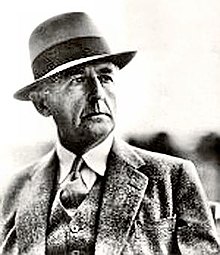Condé Nast (businessman)

Condé Montrose Nast (March 26, 1873 – September 19, 1942) was the founder of Condé Nast Publications, a leading American magazine publisher known for publications such as Vanity Fair, Vogue, and The New Yorker.
Background
Named after his uncle Condé L. Benoist, Condé Montrose Nast was born in New York City to a family of Midwestern origin. His father, William F. Nast (son of the German-born Methodist leader William Nast) was an inventor who had served as U.S. attaché in Berlin. His mother, the former Esther A. Benoist, was a daughter of pioneering St. Louis banker Louis Auguste Benoist and a descendant of a prominent French family that emigrated to Canada and then to Missouri.
He had three siblings: Louis, Ethel, and Estelle.
Nast's aunt financed his studies at Georgetown University, from which he graduated in 1894. During his studies, he was the first president of Georgetown's early student government, The Yard, and he was a member of Georgetown's debating organization, the Philodemic Society.[1] He stayed on an extra year to receive a Master's degree from Georgetown in 1895.[2] He went on to earn a law degree from Washington University in St. Louis in 1897.
Career

Nast did not take well to law, and upon graduation he got a job working for a former Georgetown classmate, Robert Collier, as advertising manager for Collier's Weekly (1898–1907). Over the course of a decade he increased the advertising revenue 100-fold. He published books and Lippincott's Monthly Magazine with Robert M. McBride (McBride, Nast & Co.). After leaving Collier's, Nast bought Vogue, then a small New York society magazine, transforming it into one of America's premier fashion magazines.
He then turned Vanity Fair into a sophisticated general interest publication, with the help of his friend Frank Crowninshield, who was editor and a major influence for more than twenty years. It published many new and high quality writers, as well as displaying reproductions of modern art.
Nast eventually owned a stable of magazines that included House & Garden, British, French, and Argentine editions of Vogue, Jardins des Modes, and Glamour (the last magazine added to the group while he was alive). While other publishers simply focused on increasing the number of magazines in circulation, Nast targeted groups of readers by income level or common interest. Among his staffers were Edna Woolman Chase, who served as the editor in chief of Vogue; as well as Dorothy Parker and Robert Benchley.
Nearly ruined in the Great Depression as many others were, Nast spent his last years struggling to regain his early prosperity.
Marriages and significant relationships
Nast was married twice. His wives were:
- (Jeanne) Clarisse Coudert, a Coudert Brothers law-firm heiress who became a set and costume designer. Married in 1902, separated in 1919, and divorced in 1925,[3] they had two children, Charles Coudert Nast and Natica Nast,[4] an artist (who married Gerald F. Warburg, a banking heir and professional cellist and conductor).[5] After her divorce from Nast, Clarisse Coudert Nast married J. V. Oñativia (See photographs of Clarisse Nast on Wikimedia Commons).
-
Clarisse Coudert wearing one of the famous Fortuny tea gowns
-
Natica Nast photographed by Adolph de Meyer
- Leslie Foster (1907–1981), whom he married in 1928; a granddaughter of Gov. George White Baxter of Tennessee, the bride was 20, the groom was 55. Divorced circa 1932, they had one child, a daughter, Leslie (who married Peter George Grenfell, Baron St Just,[6][7] and Lord Bonham-Carter). After their divorce, in November 1932 Leslie Foster Nast married Lt. Col. Sir Reginald Lindsay Benson (1889–1968); they had two children.
- Between 1932 and 1936, Nast's companion was the Vanity Fair writer Helen Brown Norden Lawrenson, author of The Hussy's Handbook (1942), Latins are Still Lousy Lovers (1968), and Stranger at the Party (1975).[8][9]
Death
Condé Nast died on September 19, 1942 and is interred at Gate of Heaven Cemetery in Hawthorne, New York. His grave is located in Section 25 of the cemetery, near Babe Ruth and Billy Martin.[10][11]
References

- ^ "Notable Alumni". philodemicsociety.org. Philodemic Society. Retrieved 19 March 2015.
- ^ Dixon, Robert (1 May 1969). "Yard Fades Into Georgetown History" (PDF). Newspaper. No. Vol. 42, No. 22. The Hoya. Retrieved 19 March 2015.
{{cite news}}:|issue=has extra text (help) - ^ "Mrs. Condé Nast Sues for Divorce in Paris". New York Times. May 30, 1925. p. 9.
- ^ LINDA SASLOWPublished: June 12, 1988 (1988-06-12). "nytimes.com". New York Times. Retrieved 2013-04-28.
{{cite web}}: CS1 maint: numeric names: authors list (link) - ^ Linda Saslow (June 12, 1988). "Out of the House: A Mother's Art". New York Times. Retrieved 19 October 2010.
- ^ "Miss Nast Fiancée of Baron St. Just". The New York Times. January 24, 1949. p. 14.
- ^ "Edward Charles Grenfell biography". Grenfell Family History Site. Retrieved 2009-06-09.
- ^ Patrick O'Higgins (June 30, 1975). "Helen Lawrenson's Two Lives: Beer and Champagne, Kiss and Tell". The People. p. Vol. 3 No. 25.
- ^ Laurie Johnston (April 8, 1982). "Helen Lawrenson, 74, wrote about notable affairs". New York Times.
- ^ "Husband and Wife Reunited: After a Separation of Thirteen Years, They Come Together", The New York Times, October 14, 1890, p. 3
- ^ Condé Nast Dead; Publisher was 68", The New York Times, September 20, 1942, p. 39
External links
- 1873 births
- 1942 deaths
- American magazine company founders
- Burials at Gate of Heaven Cemetery
- Condé Nast people
- Georgetown University alumni
- Washington University in St. Louis alumni
- American people of German descent
- American people of French descent
- American people of French-Canadian descent
- People from New York City
- American male tennis players


